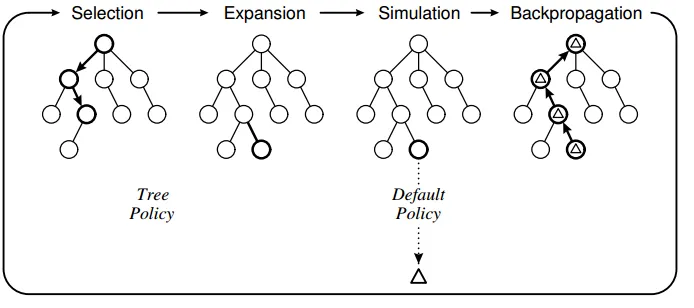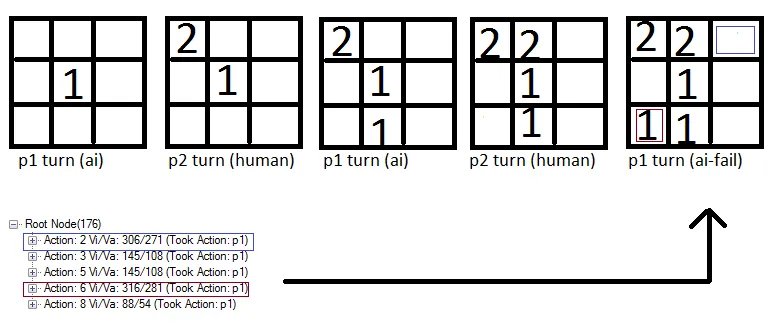编辑:上传了完整的源代码,如果您想查看是否能让AI表现更好:https://www.dropbox.com/s/ous72hidygbnqv6/MCTS_TTT.rar
编辑:搜索空间被搜索,导致失败的移动被发现。但是由于UCT算法,会很少访问导致失败的移动。
为了学习MCTS(蒙特卡洛树搜索),我使用该算法制作了经典游戏井字棋的人工智能。我使用以下设计实现了该算法:
 树策略基于UCT算法,而默认策略则是执行随机移动,直到游戏结束。我所观察到的是,有时计算机会因为无法“看到”某个特定移动将直接导致失败,而做出错误的移动。
树策略基于UCT算法,而默认策略则是执行随机移动,直到游戏结束。我所观察到的是,有时计算机会因为无法“看到”某个特定移动将直接导致失败,而做出错误的移动。
例如:
 请注意,动作6(红色方块)的价值略高于蓝色方块,因此计算机标记了这个位置。我认为这是因为游戏策略基于随机移动,因此存在很大的机会,人类不会在蓝色框中放置“2”。如果玩家没有在蓝色框中放置2,则计算机将保证获胜。
请注意,动作6(红色方块)的价值略高于蓝色方块,因此计算机标记了这个位置。我认为这是因为游戏策略基于随机移动,因此存在很大的机会,人类不会在蓝色框中放置“2”。如果玩家没有在蓝色框中放置2,则计算机将保证获胜。
我的问题
1)这是MCTS的已知问题还是实现失败的结果?
2)可能的解决方案是什么?我考虑限制选择阶段的移动,但我不确定:-)
核心MCTS代码:
//THE EXECUTING FUNCTION
public unsafe byte GetBestMove(Game game, int player, TreeView tv)
{
//Setup root and initial variables
Node root = new Node(null, 0, Opponent(player));
int startPlayer = player;
helper.CopyBytes(root.state, game.board);
//four phases: descent, roll-out, update and growth done iteratively X times
//-----------------------------------------------------------------------------------------------------
for (int iteration = 0; iteration < 1000; iteration++)
{
Node current = Selection(root, game);
int value = Rollout(current, game, startPlayer);
Update(current, value);
}
//Restore game state and return move with highest value
helper.CopyBytes(game.board, root.state);
//Draw tree
DrawTree(tv, root);
//return root.children.Aggregate((i1, i2) => i1.visits > i2.visits ? i1 : i2).action;
return BestChildUCB(root, 0).action;
}
//#1. Select a node if 1: we have more valid feasible moves or 2: it is terminal
public Node Selection(Node current, Game game)
{
while (!game.IsTerminal(current.state))
{
List<byte> validMoves = game.GetValidMoves(current.state);
if (validMoves.Count > current.children.Count)
return Expand(current, game);
else
current = BestChildUCB(current, 1.44);
}
return current;
}
//#1. Helper
public Node BestChildUCB(Node current, double C)
{
Node bestChild = null;
double best = double.NegativeInfinity;
foreach (Node child in current.children)
{
double UCB1 = ((double)child.value / (double)child.visits) + C * Math.Sqrt((2.0 * Math.Log((double)current.visits)) / (double)child.visits);
if (UCB1 > best)
{
bestChild = child;
best = UCB1;
}
}
return bestChild;
}
//#2. Expand a node by creating a new move and returning the node
public Node Expand(Node current, Game game)
{
//Copy current state to the game
helper.CopyBytes(game.board, current.state);
List<byte> validMoves = game.GetValidMoves(current.state);
for (int i = 0; i < validMoves.Count; i++)
{
//We already have evaluated this move
if (current.children.Exists(a => a.action == validMoves[i]))
continue;
int playerActing = Opponent(current.PlayerTookAction);
Node node = new Node(current, validMoves[i], playerActing);
current.children.Add(node);
//Do the move in the game and save it to the child node
game.Mark(playerActing, validMoves[i]);
helper.CopyBytes(node.state, game.board);
//Return to the previous game state
helper.CopyBytes(game.board, current.state);
return node;
}
throw new Exception("Error");
}
//#3. Roll-out. Simulate a game with a given policy and return the value
public int Rollout(Node current, Game game, int startPlayer)
{
Random r = new Random(1337);
helper.CopyBytes(game.board, current.state);
int player = Opponent(current.PlayerTookAction);
//Do the policy until a winner is found for the first (change?) node added
while (game.GetWinner() == 0)
{
//Random
List<byte> moves = game.GetValidMoves();
byte move = moves[r.Next(0, moves.Count)];
game.Mark(player, move);
player = Opponent(player);
}
if (game.GetWinner() == startPlayer)
return 1;
return 0;
}
//#4. Update
public unsafe void Update(Node current, int value)
{
do
{
current.visits++;
current.value += value;
current = current.parent;
}
while (current != null);
}